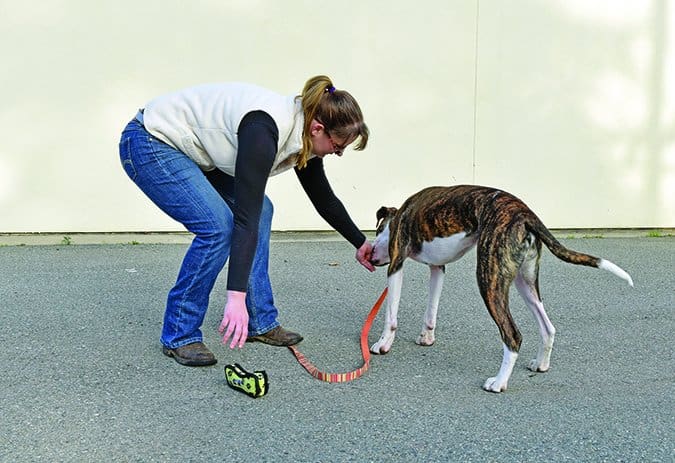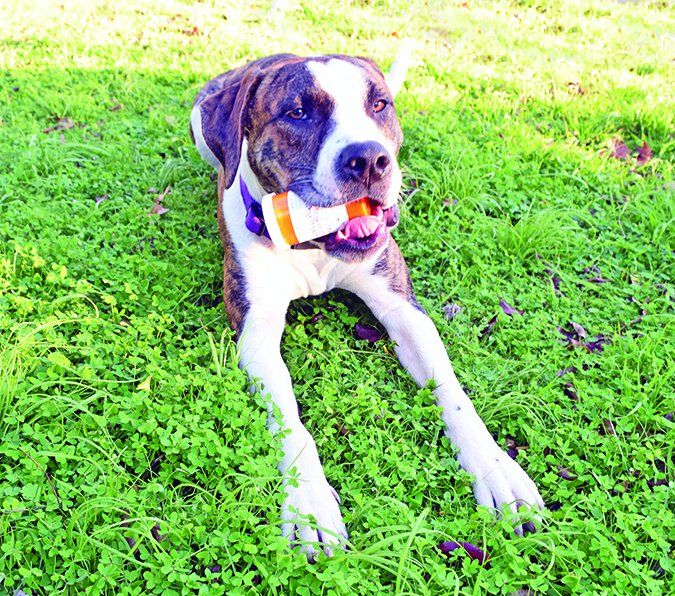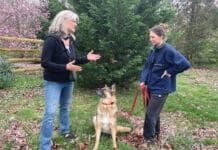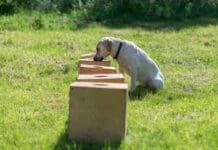Training a dog to “drop it!” is extremely useful, but what about when you’re dealing with a resource-guarding dog, or a dog who insists on turning your distress over the forbidden item into a game of keep-away? Teaching a dog to trade items with you, rather than confiscating things from him all the time, is an invaluable way to keep your valuables and your dog safe.
It’s a rare dog owner who hasn’t, on one or more occasions, had to retrieve something from her dog that the dog wasn’t supposed to have. In the best of circumstances it’s something of little or no value that the human would merely prefer the dog not ingest – a used tissue, say, or a dropped vitamin tablet. In the worst of times, it’s something invaluable – a family heirloom, for example – or something toxic to the dog, that the human must get away from the dog.
In years past, I instructed dog owners and my student dog trainers in the fine points of teaching dogs a “Leave It” behavior. To teach this behavior, I would place a high-value item (such as a cube of freeze-dried liver) under my foot, and generally, a dog would try to get it by pawing at or pushing my shoe with his nose. I would wait patiently, then mark and reinforce the dog for any behavior other than trying to get it out from under my foot – even just a brief glance away.
There is more to the technique (most recently discussed in “Teaching Your Dog to ‘Leave It’ on Cue,” in the August 2008 issue), but I won’t go into it in more detail, because I have abandoned this method for much simpler and more effective methods!
Today, my preference is to teach dogs a “Trade” behavior for those instances when the dog already has something in his mouth that I don’t want him to have, and “Walk Away,” which can be used whether the dog has a forbidden item in his mouth or has just spotted a forbidden item. Since I have incorporated these behaviors into my dogs’ and my students’ behavior repertoire, I have noticed that the behavior I want happens much more quickly and with less frustration for dogs and humans.
One possible reason for the greater success of these behaviors (compared to “Leave It”) is the fact that in these protocols, you teach the dog something to do, which is far easier for a dog to understand than something to not do. In teaching “Trade” or “Walk Away,” we show the dog how to earn treats by doing something (either trading or walking away), rather than just refraining from doing something else (grabbing or eating a certain item). These behaviors offer the dog a clear path to success!
Our 13-year-old Corgi, Lucy, has long known the “Leave It” behavior. I recently taught her the “Walk Away” behavior, and then did an experiment, setting up parallel high-value challenges and cueing “Leave It” one time, and “Walk Away” another. I randomized the cues, so that sometimes “Walk Away” came first, and sometimes “Leave It” was cued first. One hundred percent of the time she responded more quickly to the simpler “Walk Away” cue, and with softer body language, than she did to the more difficult “Leave It” cue. This small trial made a believer out of me!
Whether your dog has snatched up something he shouldn’t have, or is about to, the likelihood of your success in getting it away from him is considerably greater if you stay calm, rather than freak out and start to yell and grab or chase the dog. The potential for success skyrockets if you have previously taken the time to teach your dog one of the protocols that follows, so your dog actively, happily, and willingly relinquishes that or any other object on cue.
Note: These behaviors will be easiest to teach if you haven’t already created an adversarial relationship with your dog over his ill-gotten gains. If you’ve attempted to forcefully remove things from your dog’s mouth and he is now a serious resource-guarder, enlist the help of a qualified force-free trainer before attempting to teach “Trade.” (See “Resource Guarding and What to Do About It,” WDJ August 2015, for more information about resource-guarding.) If you’ve chased him when he had things he ought not, he may think “keep away” is fun, in which case, you’ll need to convince him that “Trade” is a better game.
Teaching Your Dog the ‘Trade’ Cue
In teaching your dog “Trade,” you are promising to give him something of value in exchange for the valuable item he has in his mouth. (Cat poop may be abhorrent to humans, but it is of very high value to many dogs!)
Here’s how to teach “Trade.”
1. Say “Take it!” and give your dog a low-value object.
Offer your dog something he will easily and willingly give up in exchange for the high-value treat you will offer him next. (If his first instinct is to take the item and run, you may need to put a leash on him and step on the leash or tether him to something solid, so he can’t run off with the item before he realizes there are more potential benefits to this negotiation!)
2. Offer your dog some high-value treats.
You may need to hold the treats close enough to his nose that he can smell them, but don’t try to push them into his mouth; anything that resembles coercion will likely increase his resistance. Make sure you have a large enough supply of the high-value treats that it will take him a few moments to eat them.
If he doesn’t drop the object he has in his mouth in favor of your treats, you need a higher-value treat (think meat, not dry biscuits) and/or a lower-value item to trade for.
Notice you didn’t use a cue yet. We don’t add the cue until we know the dog will drop the item.

3. When your dog drops the item:
Click your clicker (or use a mouth click or verbal marker, such as the word “Yes!”), and while you keep him occupied nibbling at the high-value treats in one hand, with your other hand, pick up the object and hide it behind your back. This part is really important. You must use two hands! If you let him eat the high-value treat and them try to race him back to the object, you’re likely to lose the race – and you may elicit resource-guarding.
If you feel at all uncomfortable reaching for the item as your dog munches on the treats, you can sprinkle the treats in a short “Hansel and Gretel” trail, starting under his nose and leading to a spot a foot or two away from the dropped item. Engage his mouth with the treats in your hand after he follows the trail, while you pick up the item with your other hand.
4. As soon as your dog finishes eating the treats in your hand:
Bring out the object from behind your back, say, “Take it!” and give it back to him. This teaches him that he doesn’t always lose the item; he can trade with you and then get the item right back. This will make him more willing to trade again in the future. He gives you his good stuff, he gets more good stuff, and then he gets good stuff back again. It’s a win/win for him!
5. When you can reliably predict that your dog will drop the item when you offer your treats, add the cue.
Give your cue first (“Trade!”), and pause for a second or two. Then offer the treats, click (or say “Yes!”) when he drops the item, and pick up the item with your free hand while you keep his mouth busy nibbling treats from your hand.
6. After several repetitions, sometimes pause a few seconds longer before offering your dog treats.
Your goal is to get him to drop the object when you say, “Trade!” before you offer the treats. When he will do this reliably, it means you have the behavior “on cue” – that is, he is dropping the object because he heard and understood the cue, not just because you stuck high-value treats under his nose.
While ideally you will always have something in hand (or in pocket) to offer your dog in trade, if you train this behavior well enough and practice it often, in an emergency your dog will still give up that poisonous mushroom (or whatever) when he hears the “Trade!” cue. This is most likely to work if you use your cheerful “training game” voice and not an “Omigosh, it’s an emergency” panicked voice. Your training diligence might even save your dog’s life!
Teach Your Dog to ‘Walk Away’
In addition to the invaluable “Trade” cue, you can also teach your dog a very useful “Walk Away” behavior. This is particularly useful before your dog has a forbidden object in his mouth, but it can also be effective after he has picked up something you don’t want him to have.
I was introduced to this protocol by friend and fellow behavior professional Kelly Fahey, PMCT2. Fahey created this approach, based on Patel’s “Drop it” protocol (described below), as a simpler and less-frustrating alternative to “Leave It.” It can also be used to help modify resource-guarding.
Note: If at any point during the protocol you see resistance, tension, or signs of aggression in your dog, back up a few steps and proceed again more slowly, with more repetitions at each step. If your dog is prone to guarding and you are concerned about your safety or the safety of family members, seek the assistance of a qualified force-free professional to help you modify his guarding behavior.
Here’s how to teach “Walk Away.”
1. Say to your dog, “Walk away!” in a cheerful voice and toss several treats on the ground.
Point at the treats as the dog finds them (at a safe distance if your dog is likely to guard the food). Repeat 10-12 times (or more) until dog eagerly responds to the “Walk away!” cue.
While in most cases, you add a cue only after you are reliably eliciting a certain behavior, in this case, you are giving your dog a positive association with the cue before you introduce the potential for conflict with having something in his mouth. And by pointing at the food, you give your dog a positive association with your hand in the vicinity of treats on the ground, to avert or reduce the potential for resource-guarding.
2. Place a neutral object (one that’s not valuable to your dog) on the ground.
When your dog sniffs it, say, “Walk away!” and toss several treats on the ground, about two to four feet from the object. Point at the treats as the dog finds them; again, and in every single step that follows, point from a safe distance if your dog is prone to guarding food. Repeat at least 10-12 times (or more), until your dog immediately moves away from the object in response to the cue. Use a variety of objects as the neutral object if necessary to keep your dog interested in approaching and then “walking away” from them.
3. Place an object that is of relatively low value to your dog on the ground.
Perhaps a toy that he sometimes plays with (not one of his favorites) or a type of biscuit he will only sometimes eat. When your dog approaches or sniffs it, say, “Walk away!” and toss several treats on the ground, about two to four feet from the object. Point at the treats as the dog finds them. Repeat at least 10-12 times (or more) until your dog immediately moves away from the object in response to the cue. Use a variety of objects if necessary to reignite his interest.
4. Place an object that is of slightly greater value to your dog on the ground.
When your dog sniffs it, say, “Walk away!” and toss several treats on the ground, about two to four feet from the object. Point at the treats as the dog finds them. Repeat at least 10-12 times (or more) until your dog immediately moves away from the object in response to the cue. Use a variety of objects if necessary.
5. Place an object that is of high value to your dog on the ground.
When your dog sniffs it, say, “Walk away!” and toss several treats on the ground two to four feet from the object. Point at the treats as the dog finds them. Repeat at least 10-12 times (or more) until your dog immediately moves away from the object in response to the cue. Use a variety of objects if necessary.
6. Place an empty dog food bowl on the ground.
When your dog sniffs it, say, “Walk away!” and toss several treats on the ground, about two to four feet from the object. Point at the treats as the dog finds them. Repeat at least 10-12 times (or more) until your dog immediately moves away from the bowl in response to the cue.
7. Put a handful of relatively low-value dog food (such as dry kibble) in a food bowl and place it on the ground.
When your dog sniffs it, say, “Walk away!” and toss several treats on the ground, about two to four feet from the object. Point at the treats as the dog finds them. Repeat at least 10-12 times (or more) until your dog immediately moves away from the bowl in response to the cue.
8. Put a handful of higher-value dog food (such as kibble mixed with a little canned food) in a bowl and place it on the ground.
When your dog sniffs it, say, “Walk away!” and toss several treats on the ground, about two to four feet from the bowl. Point at the treats as the dog finds them. Repeat at least 10-12 times until your dog immediately moves away from the bowl in response to the cue.
9. Put a handful of high-value dog food (such as canned food or meat) in a food bowl and place it on the ground.
When your dog sniffs it, say, “Walk away!” and toss several treats on the ground, about two to four feet from the bowl. Point at the treats as the dog finds them. Repeat at least 10-12 times until your dog immediately moves away from the bowl in response to the cue.
10. When your dog is relaxed and happily moving away from objects and/or food bowls:
Add a “pick up the object or bowl” step into the protocol. Say, “Walk away!” and toss treats, then pick up the object or bowl, hand-feed him a few treats, and put object or bowl back on ground as you toss a few additional treats near the object/bowl.
Teaching Your Dog to ‘Drop It’
British trainer Chirag Patel, CPDT-KA, DipCABT, owner of Domesticated Manners in London, has developed another alternative, an innovative protocol for asking your dog to give up something in her mouth. It’s demonstrated beautifully in a video you can watch on YouTube.
Patel starts with a dog who actually has nothing in her mouth. He gives a signal – a bright, cheery, “Drop!” – that is immediately followed by high-value food treats being immediately tossed on the ground near the dog. He points to and even flicks the treats on the ground with his fingers, to bring the dog’s attention to each little tidbit; this helps the dog become accustomed to and comfortable with a human hand reaching down and toward the dog’s treats.
Patel recommends practicing many repetitions of this exercise, and incorporating it into every sort of activity around the house and yard: while sweeping the kitchen, carrying a bag of trash out to the garage, sitting on the couch, and so on. The goal is to get the dog to understand that you might give the cue at any time, in the midst of any activity, and it always means treats are about to be flung her way!
Once the dog understands the cue “Drop!” as a signal that treats are on the way, and she starts scanning the nearby ground for the treats immediately after hearing the cue, Patel introduces an item to the training environment that the dog shouldn’t have much interest in. If the dog so much as looks toward the item, he gives the “Drop!” cue, and tosses the treats, pointing each one out to the dog each time.
After many repetitions, the next step is the introduction of a low-value toy; Patel waits for the dog to sniff or pick up the toy, and then gives the “Drop!” cue and tosses the treats. If the exercise has been sufficiently practiced, the dog should immediately drop the toy and enthusiastically pursue the treats as she has so many times before.
The exercise is repeated many times with increasingly valuable toys, and even food items, as the dog becomes completely comfortable with the concept that “Drop!” means treats are on the way, and her human will even help her find each one.
In the video, Patel demonstrates that with enough repetitions of the Drop exercise, the dog becomes completely unconcerned about immediately dropping whatever she might have in her mouth and allowing the person to take the item; she learns that the cue signals that she will certainly gain lots of terrific treats, and will almost always also be given the item back.
Use the Trading Tool Most Useful to You
These protocols can get you and your dog out of a lot of difficult situations. I daresay “Trade” saved my relationship with Bonnie, another one of our dogs, which could have gone very badly if I was still an old-fashioned coercion-based dog trainer when we adopted her (see below).
In addition, numerous clients have shared stories with me where “Trade” has literally saved their dogs’ lives, by enabling them to retrieve a toxic object from their dogs’ mouths, hassle-free. If you have an inspiring “Trade,” “Walk Away” or “Leave It” experience, we’d love to hear it!
Dogs Who Understand Currency
Our dog Bonnie, now 12 years old, has always been very oral, so “Trade” has been a life and relationship-saver for us. Even now as a maturing senior, she will pick up random objects she finds on the floor. In fact, she has learned that if she brings me small pebbles from our driveway that get tracked into our house on our shoes, I will reliably trade her for a treat.
In the old days (more than two decades ago), prior to my crossover to force-free training, I would have found this annoying at best, and probably punished her for her naughtiness. Today, instead, I take pride in her cognitive abilities – she recognizes the value of currency!
Think about it. Those wrinkled pieces of green paper in your wallet have no intrinsic value. You can’t eat them, they don’t keep you warm, and they aren’t entertaining. They are only valuable because you can trade them for food, shelter, clothing, tuition, books, tickets to movies, and other goods that do have intrinsic value. Pebbles have no intrinsic value to Bonnie. She can’t eat them (well, she could, but they have no nutritional value or taste), she can’t buy her way into a movie theater, and they don’t keep her warm. But she has learned that she can trade them for treats – she can buy food with them. She has learned the value of pebble money. If you ask me, that’s pretty smart – and pretty darned cognitive!
Author Pat Miller, CBCC-KA, CPDT-KA, is WDJ’s Training Editor. She and her husband Paul live in Fairplay, Maryland, site of her Peaceable Paws training center. Miller is also the author of many books on positive training. Her newest is Beware of the Dog: Positive Solutions for Aggressive Behavior in Dogs (Dogwise Publishing, 2016).






